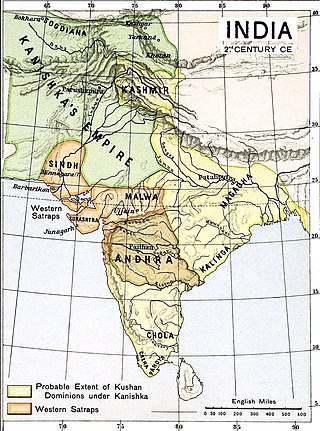
Khasas were an ancient Indo-Aryan tribe and a late Janapada kingdom from Himalayan regions of northern Indian subcontinent mentioned in the various historical Indian inscriptions and ancient Indian Hindu and Tibetan literatures. European sources described the Khasa tribe living in the Northwest Himalayas and the Roman geographer Pliny The Elder specifically described them as "Indian people". They were reported to have lived around Gandhara, Trigarta and Madra Kingdom as per the Mahabharata.
Daradas were a people who lived north and north-west to the Kashmir valley. This kingdom is identified to be the Gilgit region, in the Gilgit-Baltistan region along the river Sindhu or Indus. They are often spoken along with the Kambojas. The Pandava hero Arjuna had visited this country of Daradas during his northern military campaign to collect tribute for Yudhishthira's Rajasuya sacrifice.
The Chinas, Cīna, or Chīnaḥ are a people mentioned in ancient Indian literature from the first millennium BC and first millennium AD, such as the Mahabharata, Laws of Manu, and the Puranic literature.
The historical Avanti Kingdom of ancient India is described in the Mahabharata epic. Avanti was divided into north and south by river Vetravati. Initially, Mahissati was the capital of Southern Avanti, and Ujjaini was of northern Avanti, but at the times of Mahavira and Buddha, Ujjaini was the capital of integrated Avanti. The country of Avanti roughly corresponded to modern Malwa, Nimar and adjoining parts of the Madhya Pradesh.
Madra Kingdom was a kingdom grouped among the western kingdoms in the epic Mahabharata. Its capital was Sagala in Madra region, modern Sialkot in the Punjab province of Pakistan. The Kuru king Pandu's (Pāṇḍu) second wife was from Madra kingdom and was called Madri. The Pandava twins, Nakula and Sahadeva, were her sons. Madri's brother Shalya was the king of Madra. Though affectionate to the Pandavas, he was tricked to give support to Duryodhana and fought against the Pandavas during the Kurukshetra War. He was killed by Yudhishthira, the eldest Pandava. Other than the Madra kingdom with Sagala as its capital, it is believed that there was a Western Madra and a Northern Madra.

Gandhāra was an Ancient Indian kingdom mentioned in the Indian epics Mahabharata and Ramayana. Gandhara prince Shakuni was the root of all the conspiracies of Duryodhana against the Pandavas, which finally resulted in the Kurukshetra War. Shakuni's sister was the wife of the Kuru king Dhritarashtra and was known as Gandhari after the area of Gandhāra. Puskalavati, Takshasila (Taxila) and Purushapura (Peshawar) were cities in this Gandhara kingdom. Takshasila was founded by Raghava Rama's brother Bharata. Bharata's descendants ruled this kingdom afterwards. During the epic's period, the kingdom was ruled by Shakuni's father Suvala, Shakuni and Shakuni's son. Arjuna defeated Shakuni's son during his post-war military campaign for Yudhishthira's Aswamedha Yagna.
The Pahlava Kingdom is identified to be a kingdom of an Iranian tribe. The kingdom was well known, even during the campaign of Alexander. It was also mentioned in the epic Mahabharata.

The kingdom of Tushara, according to ancient Indian literature, such as the epic Mahabharata, was a land located beyond north-west India. In the Mahabharata, its inhabitants, known as the Tusharas, are depicted as mlechchas ("barbarians") and fierce warriors.
Sakas are described in Sanskrit sources as a Mleccha tribe grouped along with the Yavanas, Tusharas and Barbaras. There were a group of Sakas called Apa Sakas meaning water dwelling Sakas, probably living around some lake in central Asian steppes. Sakas took part in Kurukshetra War.
Khasas were a north western tribe mentioned in the epic Mahabharata.
Kasmira was a kingdom identified as the Kashmir Valley along the Jhelum River of modern Jammu and Kashmir. During the epic ages this was one among the territories of the Naga race. The Kasmiras were allies of the Kuru king Duryodhana.
Hunas were a tribe close to Himalayas that, because of limited interaction with Indian kingdoms, were mentioned in the epic Mahabharata. They belonged to the Xinjiang province of China, east of Jammu-Kashmir. However, they were nomadic people who changed their settlements from time to time.

Hara-Huna was an ancient kingdom and inhabited by the Hara Hunas tribe close to the Himalayas who had limited interaction with the Indian kingdoms, thus they were identified in the epic Mahabharata.

Andhra was a kingdom mentioned in the epics Ramayana and Mahabharata. It was a southern kingdom, currently identified as Indian state of Andhra Pradesh which got its name from.
Dravida is mentioned as one of the kingdoms in the southern part of present-day mainland India during the time of the Mahabharata.
The Keralas or Udra Keralas were a royal dynasty mentioned in Sanskrit epics of ancient India. In the Mahabharata, the Keralian Empire took part in the Kurukshetra War by feeding both armies. According to the Puranas, the navigators and survivors of the Yadavas of Dwaraka also settled in Kerala later. Some remnants of the Naga culture are also found here.
Kanchi was a southern kingdom mentioned in the epic Mahabharata. This kingdom took part in the Kurukshetra War.

Kirata Kingdom in Sanskrit literature and Hindu mythology refers to any kingdom of the Kirata people, who were dwellers mostly in the Himalayas. They took part in the Kurukshetra War along with Parvatas (mountaineers) and other Himalayan tribes.

The Pahlavas are a people mentioned in ancient Indian texts like the Manu Smriti, various Puranas, the Ramayana, the Mahabharata, and the Brihat Samhita. According to P. Carnegy, In the 4th century BCE, Vartika of Katyayana mentions the Sakah-Parthavah demonstrating an awareness of these Saka-Parthians, probably by way of commerce.
The Bahlikas were the inhabitants of Bahlika, mentioned in Atharvaveda, Mahabharata, Ramayana, Puranas, Vartikka of Katyayana, Brhatsamhita, Amarkosha etc. and in the ancient Inscriptions. The other variations of Bahlika are Bahli, Balhika, Vahlika, Valhika, Bahlava, Bahlam/Bahlim, Bahlayana and Bahluva.



